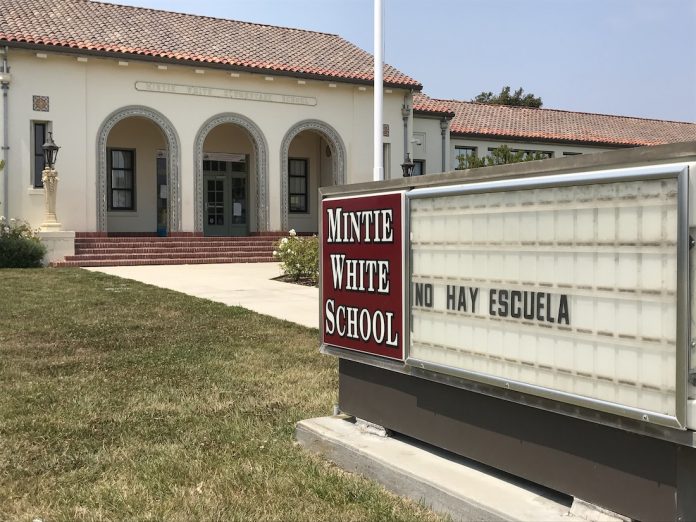SANTA CRUZ COUNTY—Teachers throughout Santa Cruz County are getting their Covid-19 vaccines, a daunting task that is moving the needle a tiny bit closer for a plan to return students to the classroom.
But with unpredictable vaccine supplies, thousands of educators and school employees still in line to get their shots, and Covid-19 case rates that keep the county in the most restrictive purple “widespread” tier of the state’s reopening plan, it’s not clear when that return will occur.
Pajaro Valley Unified School District Superintendent Michelle Rodriguez says it could happen before the end of the school year, if the vaccines make it to all school employees and the case rate continues to decline.
“We feel really confident that we will be able to do a phased-in return to school after spring break,” Rodriguez said. “We believe now that we have more of a clear path than we’ve ever had, but it is contingent on the vaccines.”
Spring break for PVUSD is March 29-April 2.
Pajaro Valley Federation of Teachers President Nelly Vaquera-Boggs said that any decision to open must involve the unions.
“Our position is that the local service area rate needs to be lower, not in Purple, and teachers need to be vaccinated,” she said.
Those talks are ongoing, says Santa Cruz County Office of Education Superintendent Faris Sabbah.
“If we are to be able to move forward with reopening, we want to make sure that certificated and classified staff are all there to help,” he said.
Sabbah estimated on Tuesday that 500 school employees have been vaccinated countywide.
Locally, the situation is on a positive trend.
The county’s adjusted case rate recently fell below the state’s threshold (25 per 100,000 per day) needed to reopen in-class learning for grades K-6. That means districts could start applying to the state for waivers to bring students back to campuses that have largely sat empty since March 2020.
But the waiver process is tricky. It not only requires buy-in from the district’s board of trustees, but also from the parents and the labor groups that have been cautious to step back into the classroom during the pandemic.
There are no plans in PVUSD to apply for a waiver.
Classified and certificated employees who work with preschool, transitional kindergarten and kindergarten students have received vaccines, as have elementary custodians, health care assistants and food service workers.
Bus drivers, and staff who work in the district’s safe spaces are set to receive theirs starting this weekend, as are teachers who work with multiple grades, Rodriguez said.
One trouble, she said, is that the number of vaccines coming from the state and county is unpredictable.
County spokesman Jason Hoppin said that teachers are already eligible to receive their vaccine through their healthcare provider because they are part of the Phase 1B rung of county and state vaccination plans, which, after those 65 and older, prioritizes essential workers such as teachers, emergency personnel and farmworkers, among others.
The trouble, however, is that Phase 1B encapsulates roughly a quarter of the state and county’s population, and that vaccine doses are still scarce. Deputy County Health Officer Dr. David Ghilarducci said at a Feb. 4 press conference that the county receives, on average, 2,000 doses every week, though the actual number varies wildly by each distribution. Most of those doses are being prioritized for older adults in the Watsonville area.
The county does not expect to be done vaccinating those 65 and older for weeks—though that could change with the addition of the Johnson & Johnson and AstraZeneca vaccines, Ghilarducci said.
As of Wednesday, about 22,000 county residents had been vaccinated—receiving both doses of either the Pfizer or Moderna vaccine—through various avenues.
Indeed, the unpredictability of the supplies has meant that teachers don’t get notified until a few days before the appointments are available, Vaquera-Boggs said.
When that happened to early childhood education teachers recently, only 40 percent of that population was able to receive their vaccines, she said.
“We are getting notified two days before these vaccines are available to the teachers,” she said.
Yet health experts and politicians nationwide, including California Gov. Gavin Newsom, have argued that vaccines should not be required for teachers to return to the classroom, especially for those working in the K-6 grades.
The Centers for Disease Control and Prevention Director Dr. Rochelle Walensky told reporters earlier this month that “There is increasing data to suggest that schools can safely reopen. And that that safe reopening does not suggest that teachers need to be vaccinated in order to reopen safely.”
County Health Officer Dr. Gail Newel echoed Walensky at the Feb. 4 press conference, and said that children in the K-6 grades “need the classroom situation more, and they’re at very low risk of spreading disease through the community, to each other and to the educators.”
Most of the evidence, Newel added, suggests that the spread in education is happening from adult to adult in break rooms and other social situations outside of the school setting.
Despite that, school districts across the state have been slow to reopen their doors, as several unions have battled for additional resources such as increased testing and vaccines. One of those fights recently turned into a legal squabble, as the County of San Francisco sued its own school district for not reopening.
Asked whether a similar situation would halt her office from supporting districts from applying for a reopening waiver, Dr. Newel said bluntly that she would base her decisions on data.
“We work by evidence and advocacy is not going to change our mind,” she said.
Grades 7-12 are not allowed to return to in-person classes until the county moves into the less restrictive Red “Substantial” Tier of the state’s reopening plan. However, that would require the county’s adjusted case rate to drop below seven cases per 100,000 people. The case rate is currently at 18.8.
Managing Editor Tony Nuñez contributed to this report.









